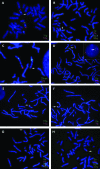Subtelomere FISH analysis of 11 688 cases: an evaluation of the frequency and pattern of subtelomere rearrangements in individuals with developmental disabilities
- PMID: 16199540
- PMCID: PMC2564531
- DOI: 10.1136/jmg.2005.036350
Subtelomere FISH analysis of 11 688 cases: an evaluation of the frequency and pattern of subtelomere rearrangements in individuals with developmental disabilities
Abstract
Background: Subtelomere fluorescence in situ hybridisation (FISH) analysis has increasingly been used as an adjunct to routine cytogenetic testing in order to detect small rearrangements. Previous reports have estimated an overall abnormality rate of 6%, with a range of 2-29% because of different inclusion criteria.
Methods: This study presents data compiled from 11 688 cases referred for subtelomere FISH testing in three clinical cytogenetic laboratories.
Results: In this study population, the detection rate for clinically significant subtelomere abnormalities was approximately 2.5%, with an additional 0.5% detection of presumed familial variants. Approximately half of the clinically significant abnormalities identified were terminal deletions, the majority of which were de novo. Most of the remaining cases were unbalanced translocations between two chromosomes or two arms of the same chromosome. Approximately 60% of the unbalanced translocations were inherited from a parent carrying a balanced form of the rearrangement. Other abnormalities identified included tandem duplications, apparently balanced translocations, partial deletions, and insertions. Interestingly, 9 cases (0.08%) were found to have interstitial deletions of non-telomeric control loci, either BCR on 22q or PML on 15q. The most common clinically significant imbalances found were deletions of 1p, 22q, 4p, 9q, 8p, 2q and 20p. The most common familial variants were a deletion or duplication of 10q, deletion of 4q, deletion of Yq, and duplication of X/Yp onto Xq.
Conclusions: This study of subtelomere rearrangements is a 20 fold increase in number over the previously reported largest study and represents an unbiased analysis of subtelomere rearrangements in a large, unselected patient population.
Conflict of interest statement
Competing interests: J B Ravnan and J H Tepperberg have previously been compensated for speaking about subtelomere rearrangements at a symposium sponsored by Vysis/Abbott, Inc. C L Martin has an educational research grant from Vysis/Abbott, Inc. for the development of a website for genotype/phenotype correlations of subtelomere rearrangements.
References
-
- Shevell M, Ashwal S, Donley D, Flint J, Gingold M, Hirtz D, Majnemer A, Noetzel M, Sheth R D. Practice parameter: evaluation of the child with global developmental delay: report of the Quality Standards Subcommittee of the American Academy of Neurology and The Practice Committee of the Child Neurology Society. Neurology 200360367–380. - PubMed
-
- Battaglia A, Carey J C. Diagnostic evaluation of developmental delay/mental retardation: An overview. Am J Med Genet C Semin Med Genet 20031173–14. - PubMed
-
- Biesecker L G. The end of the beginning of chromosome ends. Am J Med Genet 2002107263–266. - PubMed
-
- Knight S, Regan R, Nicod A, Horsley S W, Kearney L, Homfray T, Winter R M, Bolton P, Flint J. Subtle chromosomal rearrangements in children with unexplained mental retardation. Lancet 19993541676–1681. - PubMed
-
- Hengstschlager M, Prusa A, Repa C, Deutinger J, Pollak A, Bernaschek G. Subtelomeric rearrangements as neutral genomic polymorphisms. Am J Med Genet A 200513348–52. - PubMed
MeSH terms
LinkOut - more resources
Full Text Sources
Medical


